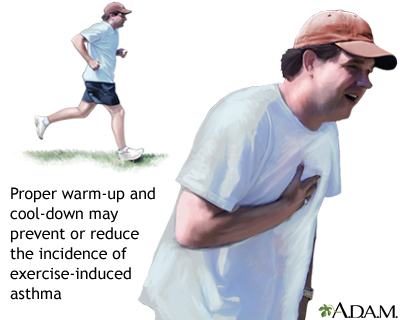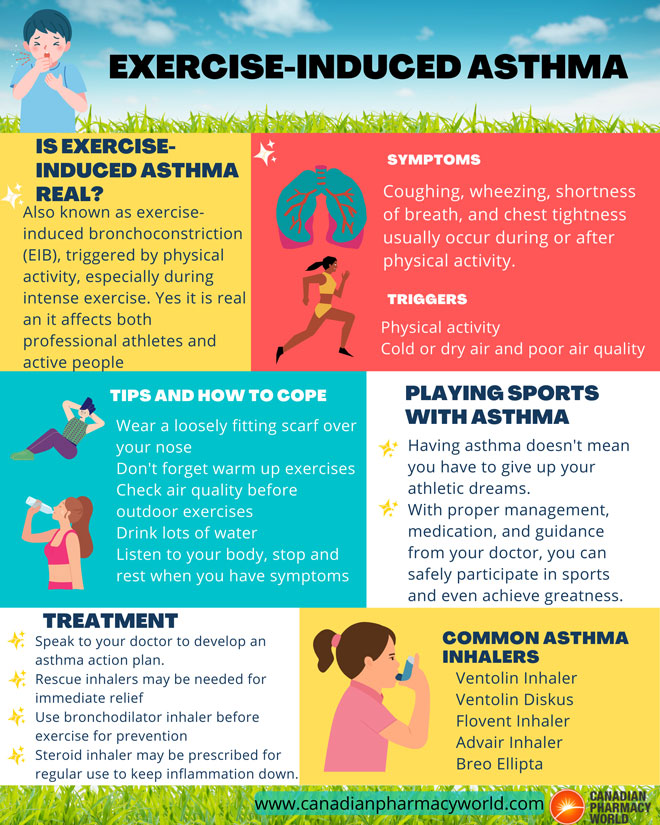Have you ever noticed tightness in your chest or trouble breathing when you exercise? You might be surprised to learn that many people experience this because of a condition called exercise-induced asthma.
But just how common is it? Understanding how many people have exercise-induced asthma can help you recognize symptoms early and take control of your health. Keep reading to discover the facts that could make your workouts easier and safer.

Credit: www.mountsinai.org
Prevalence Of Exercise Induced Asthma
Exercise induced asthma affects many people worldwide. It causes breathing problems during or after exercise. Understanding how common it is helps raise awareness. It also guides better care and treatment.
Global Statistics
About 5% to 20% of people experience exercise induced asthma. The rate varies by country and region. It is more common in places with cold or dry air. Athletes have a higher chance of this condition. Many cases remain undiagnosed or confused with other issues.
Age And Gender Differences
Children and teenagers are more likely to have exercise induced asthma. Boys show symptoms more often before puberty. After puberty, girls tend to have more cases. Adults can also develop it, but less often. Symptoms may change or improve with age.
High-risk Groups
Athletes, especially those in endurance sports, face higher risks. People living in polluted or cold climates are more affected. Those with a family history of asthma or allergies are at risk too. People with other breathing problems often experience exercise induced asthma. Awareness in these groups helps early diagnosis and care.
:max_bytes(150000):strip_icc()/play-sports-control-exercise-induced-asthma-3120183_final-ff6e7709bb1843cb8a141e597a2a238c.jpg)
Credit: www.verywellhealth.com
Symptoms And Triggers
Exercise induced asthma causes breathing problems during physical activity. Symptoms often appear quickly and can disrupt exercise routines. Knowing these signs helps in managing the condition well. Triggers vary and can worsen symptoms fast. Identifying triggers can reduce asthma attacks and improve safety.
Common Signs During Exercise
Shortness of breath is a main sign of exercise induced asthma. Wheezing, a whistling sound when breathing, often occurs. Chest tightness or pain can make it hard to continue exercising. Coughing, especially after exercise, is common. Feeling tired or weak quicker than usual also signals trouble. These signs usually start within minutes of starting activity.
Environmental And Physical Triggers
Cold air is a strong trigger for many people. Dry air can also irritate the lungs. High pollution or smoke in the environment often causes symptoms. Allergens like pollen may trigger attacks during outdoor exercise. Intense exercise or sudden changes in activity level can provoke asthma. Understanding these triggers helps in planning safe workouts.
Diagnosis Rates And Challenges
Exercise Induced Asthma (EIA) affects many people, but diagnosis rates vary widely. Identifying EIA is tricky because symptoms often overlap with other conditions. Many cases remain unnoticed or misunderstood. Accurate diagnosis is important for proper treatment and better quality of life. Challenges exist in recognizing and testing EIA effectively.
Underdiagnosis Issues
Many people with EIA do not get diagnosed. Symptoms like coughing and shortness of breath may be seen as normal tiredness from exercise. Doctors sometimes miss EIA because symptoms are mild or happen only during exercise. Lack of awareness among patients and healthcare providers adds to the problem. Underdiagnosis means many suffer without proper care or relief.
Testing Methods
Doctors use several tests to diagnose EIA. The most common is the exercise challenge test. Patients exercise under supervision while doctors monitor lung function. Another method is the bronchoprovocation test, which uses chemicals to trigger airway narrowing. These tests help confirm EIA but need special equipment and trained staff. Testing can be time-consuming and costly, limiting access for some patients.
Impact On Athletic Performance
Exercise induced asthma (EIA) affects many athletes worldwide. It can make breathing difficult during sports. This condition impacts how athletes perform. Understanding this impact helps athletes manage their health and improve their game.
Many athletes notice tightness in their chest or wheezing after intense exercise. These symptoms can lower stamina and speed. EIA can cause sudden coughing fits, making it hard to keep up with others. Performance may drop if symptoms are not controlled properly.
Effects On Professional Athletes
Professional athletes with EIA face tough challenges. Their training is intense and lasts long. Symptoms can appear during critical moments in competition. Some athletes may feel tired faster than their peers. This can affect their results and rankings.
Despite these challenges, many pros continue to compete at high levels. They work closely with doctors to manage EIA. Some even win medals and set records. Their success shows that EIA does not always stop athletes.
Managing Symptoms During Sports
Managing EIA symptoms is key for athletes. Warm-up exercises can reduce the risk of symptoms. Breathing techniques help maintain airflow during activity. Using prescribed inhalers before exercise is common. These steps allow athletes to perform better and longer.
Coaches and trainers also play a role. They watch for signs of breathing difficulty. They help athletes adjust intensity to avoid flare-ups. Proper management keeps athletes safe and competitive.
Treatment And Management
Treatment and management of exercise-induced asthma help control symptoms. This allows many people to enjoy physical activities safely. Proper care makes breathing easier during exercise and daily life. Understanding treatment options helps reduce attacks and improve health.
Medications Used
Doctors often prescribe inhalers to treat exercise-induced asthma. These inhalers open airways quickly to ease breathing. Short-acting bronchodilators are common before exercise. They work fast to prevent symptoms.
Some people need daily medications to reduce inflammation. These include corticosteroids that calm airway swelling. Leukotriene modifiers may also help control symptoms. Always follow the doctor’s advice on medicine use.
Preventive Strategies
Warming up before exercise reduces asthma risk. Start slow and increase activity gradually. Breathing through a scarf or mask can warm cold air. This helps protect airways from irritation.
Avoiding triggers like smoke, pollution, and allergens is key. Stay hydrated and rest well to support lung health. Regular check-ups help adjust treatment if needed. These steps make exercise safer and more enjoyable.
Recent Research And Surprising Findings
Recent studies reveal new facts about exercise-induced asthma (EIA). These findings help us understand how many people suffer from this condition. Researchers study causes and the number of cases worldwide. Their work shows surprising trends and ideas.
New Insights Into Causes
Scientists found that cold air often triggers EIA symptoms. Breathing dry, cold air can irritate the lungs. Pollution and allergens also play a major role. Exercise increases breathing rate, exposing lungs to these triggers more. Genetics may affect who develops EIA. Some people have a higher chance due to family history.
Trends In Incidence Rates
Studies show that EIA affects about 5% to 20% of people worldwide. Athletes and active people report more cases. Children and teens often show symptoms first. Rates seem to rise in urban areas. Pollution and lifestyle changes might explain this. Awareness and better diagnosis also increase reported numbers.

Credit: www.canadianpharmacyworld.com
Frequently Asked Questions
How Many People Have Exercise Induced Asthma Worldwide?
Exercise induced asthma affects about 5-20% of the global population. It is more common in athletes and children. The exact number varies by region and activity level. Awareness and proper management help reduce symptoms and improve quality of life.
Who Is Most At Risk For Exercise Induced Asthma?
People with a history of asthma, allergies, or respiratory infections are most at risk. Athletes, especially runners and swimmers, also have higher chances. Cold, dry air and intense exercise increase the risk of developing symptoms.
Can Exercise Induced Asthma Affect Children?
Yes, children are commonly affected by exercise induced asthma. Symptoms often appear during physical activities like running or playing sports. Early diagnosis and treatment help children participate fully and safely in exercise and sports.
What Percentage Of Athletes Have Exercise Induced Asthma?
Approximately 10-15% of athletes experience exercise induced asthma. It is more prevalent in endurance sports. Proper diagnosis and treatment allow athletes to perform at their best without symptoms disrupting their training.
Conclusion
Exercise induced asthma affects millions worldwide, especially young athletes. Many people may not realize they have it. Symptoms can be mild or strong during physical activity. Knowing how common it is helps raise awareness. Early diagnosis and treatment improve daily life.
Breathing exercises and medication can control symptoms well. Staying active remains possible with the right care. Don’t ignore signs like coughing or wheezing after exercise. Understanding this condition supports better health for everyone.
